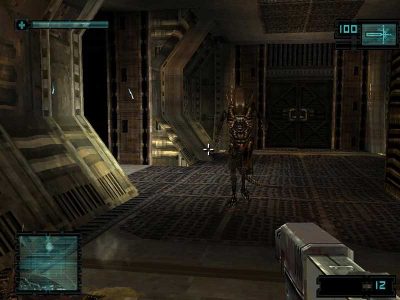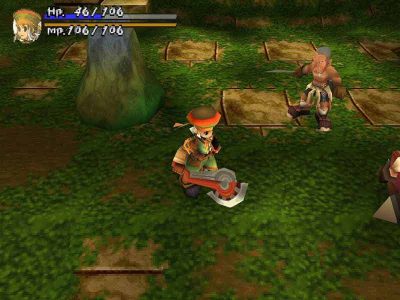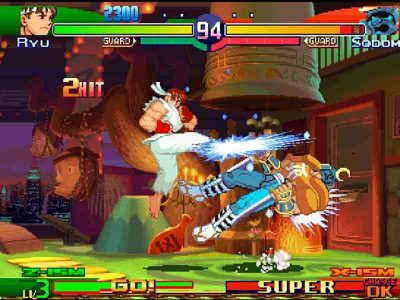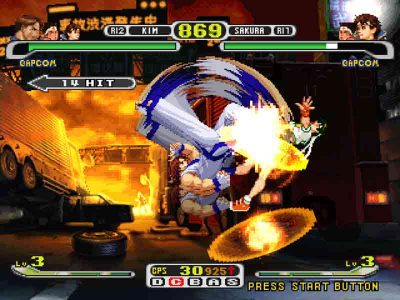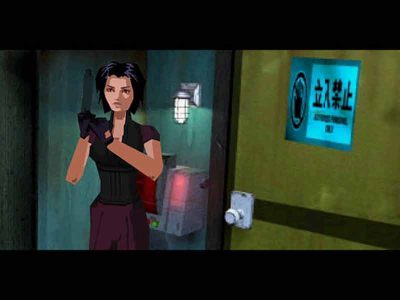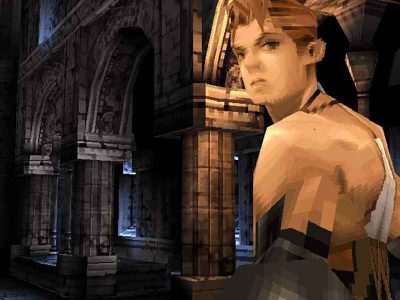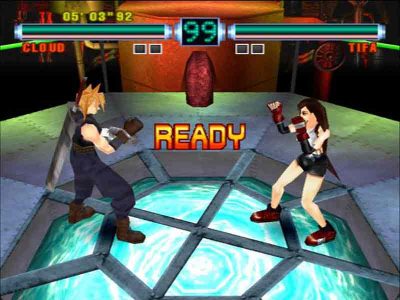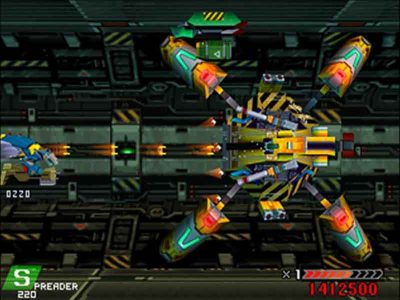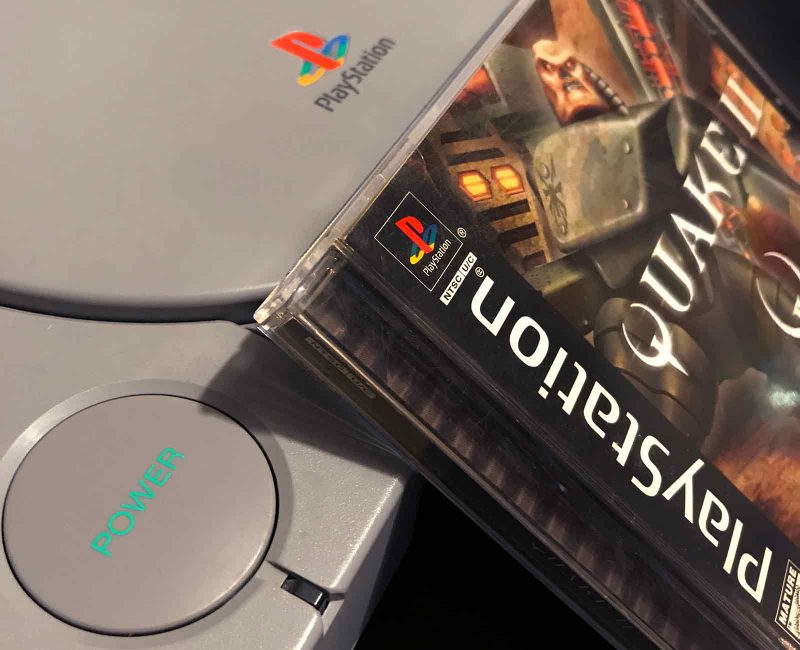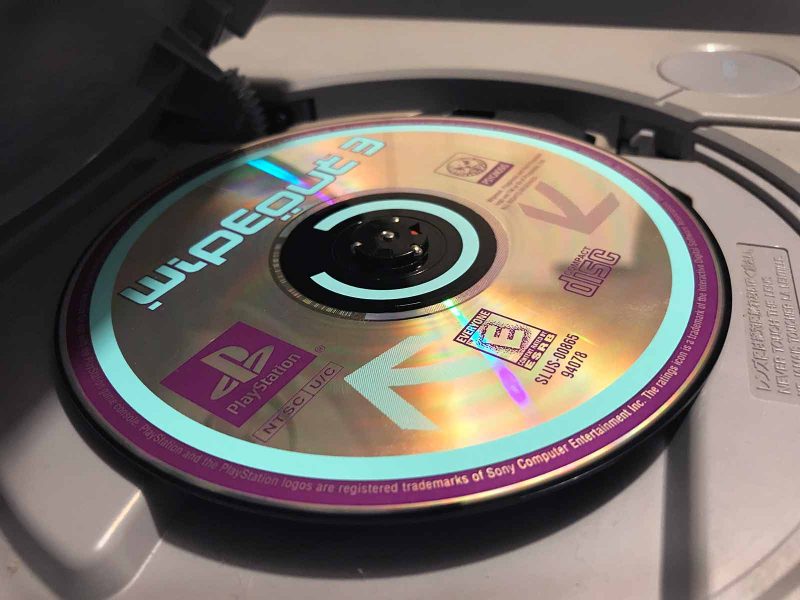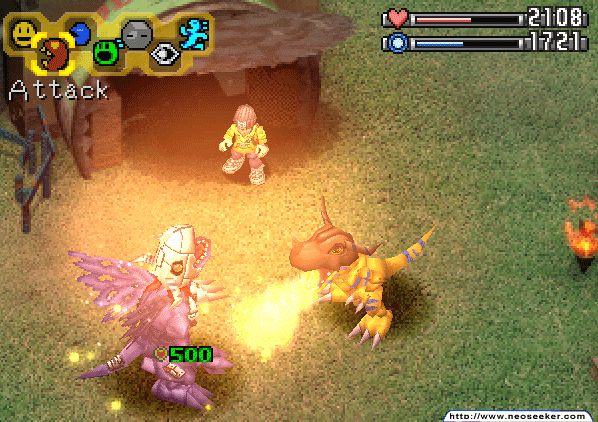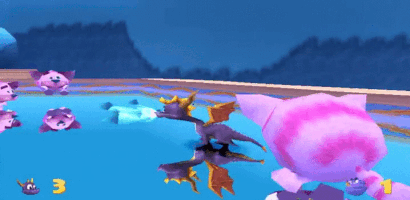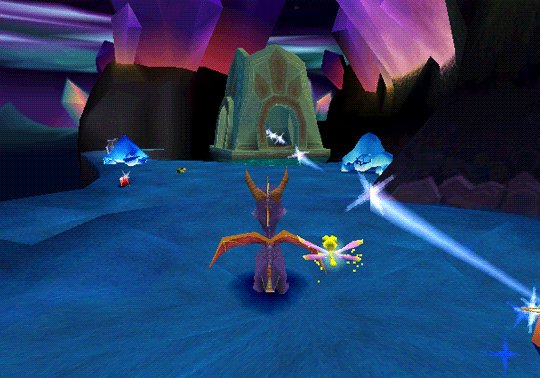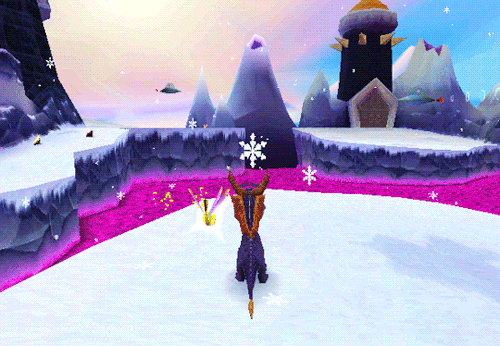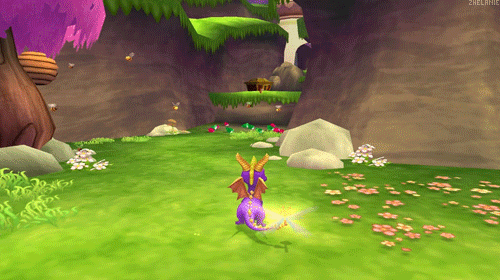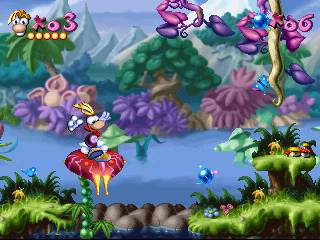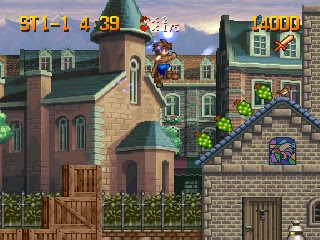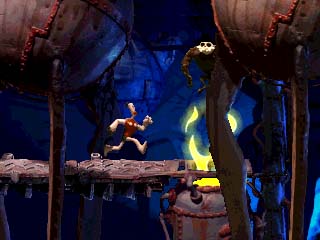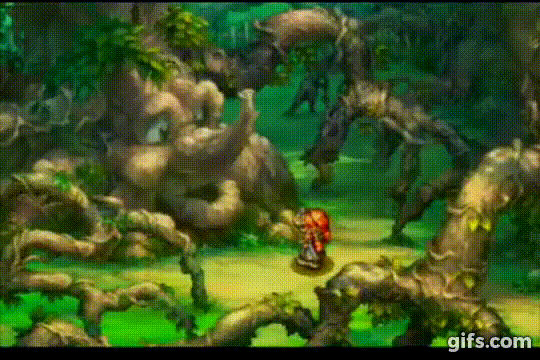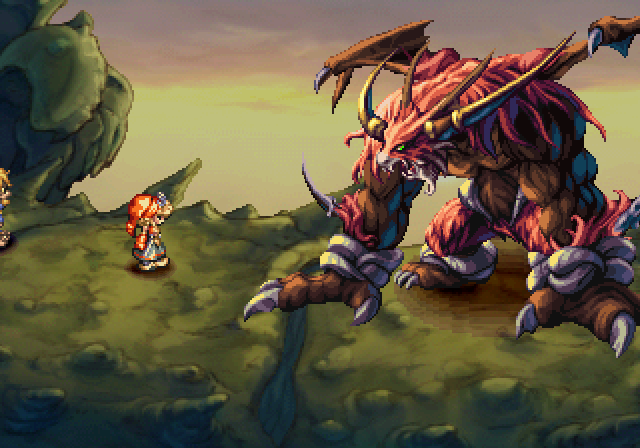Denrock
Ei mãe, 500 pontos!
- Mensagens
- 13.588
- Reações
- 70.710
- Pontos
- 584
Lista do site RacketBoy (site retrogamer que sempre curti). A opinião é do cara, mas digamos que eu tive uma pequena participação.... explicando:
Ano passado, o cara responsável pelo site RacketBoy fez um post pedindo dicas pra um artigo sobre "jogos que exploraram bem o hardware do ps1"... ... eu vi o e-mail de contato dele e escrevi uma listinha de alguns jogos que achei de poderiam entrar, ele não só leu como me respondeu pedindo uma ajuda pra fazer a lista e os motivos de cada jogo entrar. A partir daí trocamos uns 10 e-mails sobre o assunto ....
e depois de um bom tempo, a matéria do PS1 foi finalmente postada. (e agora entendi o motivo da demora, o cara procurou muito mais informações sobre alguns dos jogos da lista principal). E fico feliz que ele aceitou várias das minha sugestões de jogos, alguns na lista principal outros na de menções honrosas. Fica aí a longa matéria, vale a pena ler:
EDIT: traduzi os pontos principais de cada jogo
-----------------------------------------
http://www.racketboy.com/retro/games-that-pushed-the-limits-of-the-sony-playstation-ps1
GAMES THAT PUSHED THE LIMITS OF THE SONY PLAYSTATION (PS1)

As somebody that has a computer science background, I’m always fascinated by games that are the work of skilled developers that learned the intricacies of a console’s hardware to squeeze every last bit of performance from the machine or use some limited resources creatively to accomplish things you didn’t think was possible. Even though it did have some limitations (especially in terms of memory), the Sony Playstation hardware was well-crafted and made it easy for developers to quickly learn how to maximize performance results compared to the Sega Saturn and Nintendo 64 (read our full technical comparison).
Not to downplay some of the stunning visuals that the likes of Square’s art direction and pre-rendered elements, but there is a LOT of competition on the PS1 for some truly impressive coding that really maxed out what the Playstation was capable of. Square will indeed get some mentions below, but you might be surprised by a few developers and games that somehow stayed under the mainstream radar.
One of my other goals in this piece is to try to present diversity – not only in the types of games, but also in the ways developers worked around the limitations of the PS1. There are so many great stories of developers trying new things and accomplishing impressive feats. I hope you find them all fascinating as well!
LEGACY OF KAIN: SOUL REAVER
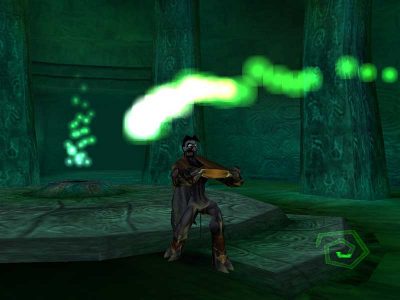
Principais recursos técnicos:
- Roda com resolução de 512 × 240 - a 30 FPS
- Mundos ambiciosos com grande atenção aos detalhes e efeitos de iluminação incríveis
- Animação de personagens que estava bem à frente de seu tempo
- Técnicas de streaming de dados para produzir mundos contínuos sem Loading
- Elemento de jogo "Dimensional Shifting" que utiliza transformação rápida entre dois ambientes de jogo alternativos
Being released in August of 1999 (after two and a half years of development) Soul Reaver was up against the upcoming US release of the Sega Dreamcast and Legend of Zelda: Ocarina of Time had redefined gamer’s expectations of action adventure titles. However, Crystal Dynamics’ labor of love ended up being possibly the biggest technical achievement of the Playstation’s library while sharing an ambitious interactive storytelling experience.
While the development drama of Soul Reaver is fascinating, we will focus on the technical achievements that came to fruition from all the long nights and drama. Soul Reaver ran on Crystal Dynamics’ proprietary Gex engine(which was originally used on Gex and built on top of what they learned while working on Tomb Raider) along with some code for character animation that they developed for 3D Baseball (which was ahead of its time in terms of motion capture, but lacked the benefits of an MLB license). The Gex engine chunked large levels into sections and then streamed the level data as needed to the system memory. It kept the player’s current section and the two adjacent sections in memory to keep loading to an absolute minimum. (In addition to the two Gex titles and Soul Reaver, the Gex engine was use used on Akuji).
Soul Reaver’s Game Director, Amy Hennig admitted that the data streaming was their biggest challenge during development:
“It proved to be way more difficult than we had initially anticipated – if I recall, we were still struggling to get the textures to dynamically pack correctly, just a couple months before release. We ultimately got it working by the skin of our teeth, but I wonder if we would’ve embarked on such an ambitious plan if we’d known how difficult it was going to be!”
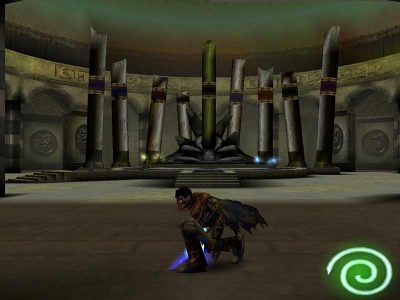
Since the CD-ROM gave developers more storage than they needed for the game, multiple copies of textures were loaded on different parts of the CD-ROM so that they were slightly quicker to access depending on where the disc was already reading. This avoidance of loading time overcame one of the most common drawbacks of the 2X CD-ROM based PS1/Saturn compared to the cartridge-based N64. Some other PS1 titles pulled off a similar strategy, but Soul Reaver was one of the first and most impressive in its execution.
To complicate the technical challenges further, the game features dimensional shifting, letting players jump between the material and spectral planes of the game at will. This gameplay element is critical to the game’s story-telling and plays in heavily for puzzle-solving elements. The developers essentially had to keep two variations of the game environment loaded at all times. Between most of the two variations the basic map data is the same, but there is an adjustment of the underlying geometry and color data.
Amy Hennig also shared that dealing with the shift in realms was the team’s second largest challenge:
“Our initial plan was over-ambitious, involving texture-morphing as well as geometry-morphing, but we realised pretty early on that our texture memory (and time) was too limited to achieve this.
We came up with the idea of leveraging the 3DS Max animation timeline to attach spectral values to the vertices in the geometry – i.e., frame 0 was the material world, and frame 1 was the spectral realm (or vice versa; I can’t remember for sure). This way we could alter the x,y,z coordinates of each vertex, as well as its RGB lighting values, to create a twisted, more eerily lit version of the physical realm.”
Soul Reaver’s soundtrack often gets a lot of acclaim. Even though it could have been simple to include pre-recorded CD audio on a PlayStation game, Soul Reaver actually uses a high-quality sequenced audio (similar to the SNES) that could dynamically altered and shifted based on what is happening on the screen. The Crystal Dynamics team was able to create a soundtrack of phenomenal quality while taking up very little storage space on the disc. DF Retro’s 36 minute Soul Reaver video digs into some of these.
On top of all this, Soul Reaver runs at a resolution of 512×240 while targeting 30 fps. While it does have some occasional slowdown dipping into the 20 fps zone during larger areas and battling larger quantities of enemies, this is still impressive considering something like Legend of Zelda: Ocarina of Time on the N64 only ran at 320×240 at about 20 fps during the same time period.
Soul Reaver contains some of most impressive character animations and lighting effects to be found in the 32-bit era. Whether he is roaming the sprawling worlds, moving blocks in this 3D puzzle adventure, hovering, or swimming, Raziel always appears to move naturally and fluidly. The levels, object types lists, color lookup tables, and variations of textures were used to efficiently display a hauntingly dynamic environment.
METAL GEAR SOLID
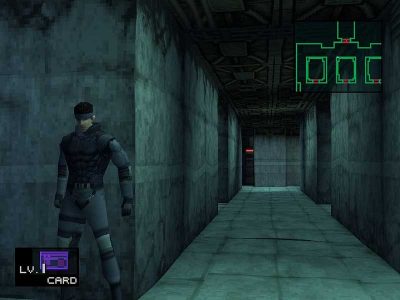
Principais recursos técnicos:
- Um estilo de jogo cinematográfico que cria uma experiência envolvente e perfeita
- Uso criativo de texturas e level design para contornar as limitações do hardware
- Otimizando partes cruciais do código e transformando-as em linguagem assembly
- Explora outras partes do hardware do PlayStation (memorycard e controle) para criar elementos de jogabilidade inovadores
Metal Gear Solid is an iconic choice for utilizing the same mind-boggling game engine for its real-time cinemas, which creates a seamless transition from a game sequence to a cut-scene. Game director Hideo Kojima had also implemented a blurring effect to give Metal Gear Solid a movie-like feel.
With many of the innovative art direction and storytelling choices made in Metal Gear Solid, it is easy to overlook many of the technical optimizations accomplished by Konami’s team to create a game that would not only make the most of the Playstation’s hardware but would be an entity that would age relatively well at such an evolutionary stage for console gaming and is one of the most defining games on the PS1.
Nearly every object in Metal Gear Solid (including Snake) is polygonal, however, Kojima and the team kept the polygon count low and leaned more on creative use of textures and rendering perspective. Thanks to these thoughtful techniques, Metal Gear Solid shows very few clipping errors and the characters move very smoothly.

Textures were also used creatively to create a more realistic and engaging environment. Rather than having a large number of unique textures, MGS creatively layered a smaller number of common textures to generate a unique look for a given surface. There was much creativity used to design and store levels – possibly using a BSP (Binary Space Partitioning ) engine since most of the game took place in corridors or boxy/cube styled levels. This technique was pioneered by the DOOM and Quake engines.
The effective use of polygons and textures was a solid foundation for Metal Gear Solid, but Konami took it one step further by having a dedicated “optimization” programmer that went through all the code to find crucial points of the engine to turn into assembly code. (Mostly to get models to fit nicely in the PS1’s small 1kb fast-cache)
On top of the already impressive game engine, the attention to detail, considering the technical limitations, is astounding. You make footprints in the snow that will eventually get covered up by snowfall. You can identify guards and other characters by their breath in the cold air. Water effects are accurate, light sourcing is dead-on, and the textures are solid.
Another way that Metal Gear Solid pushed the limits does not have anything to do with graphics, but instead it depends on the pure creativity of Kojima and the MGS team. The game had a numbers of points in the story where the memory card and/or controller is utilized creatively to enhance the game experience or serve as an “Easter egg”. If you don’t mind some spoilers, you can read more about these instances at Wikipedia.
CRASH BANDICOOT SERIES
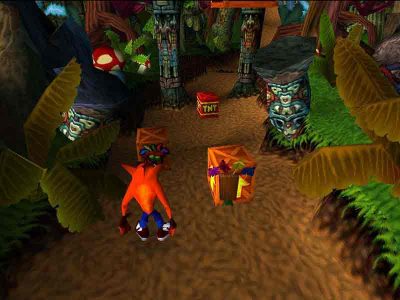
Principais recursos técnicos:
- A equipe criou seu próprio ecossistema de desenvolvimento para maximizar o hardware PlayStation para fins de plataformas 3D - completo com linguagem de programação personalizada
- Usou o modo de vídeo de 512 × 240 com muitos polígonos sombreados, mas não texturizados, para uma aparência de desenho animado e com alto desempenho.
- Sistema de multi-articulações desenvolvido para modelos de personagens para ajudar na animação semelhante a um desenho animado
- As sequências adicionaram muitos efeitos de água do tipo Z-buffer, clima, reflexos, partículas, cabeças de holograma falantes, além de um estilo de movimentação mais livre e distâncias de visualização aumentadas.
The two guys at Naughty Dog did an amazing job of being relatively new to the game dev scene and looking for an opportunity (filling the gap of a 3D platformer, Virtua Fighter and Ridge Racer/Virtua Racing had fighting and racing covered at the time, and simultaneously trying to fill a gap of a mascot character for Sony).
They also got their hands dirty quickly and kept learning as they worked on their first fully–3D game. They did a lot of impressive problem-solving and innovation, especially for a small upstart, but didn’t rest on their laurels after a single success. They continued to work on refining both the gameplay and engine of their game and also their internal development processes as they worked on the sequels. This process could easily be compared to what we have all experienced as gamers: the first time you play a game or a certain level, you’re trying to out what needs to be done to be successful. But after you made it through most of the battle the first time, you now have a better idea how to play through it again – learning from your mistakes and taking new approaches that could work better. (See this classic scene from Scott Pilgrim vs The World ** spoilers **) While the original Crash Bandicoot was pushing the PlayStation when it arrived, this constant refinement and growth at Naughty Dog resulted in Crash 3 pushing the limits all the more.(You can read about Naughty Dog’s evolution in their processes here)

Naughty Dog started Crash’s foundation by utilizing the 512×240 video mode that most developers skipped, but when they used it for shaded, but untextured polygons, they realized that it resulted in a sharper, more cartoon-like result that rendered just as fast as the lower-resolution modes. They also were able to use more polygons, so they worked around the PS1’s lack of texture correction and polygon clipping.
To help with the more cartoon-like animation, they used a sophisticated three or four-joint weighing system instead of a 1-joint system with few “bones” that a lot of developers were using at the time. They used high-end animation software on their PCs and then mapped every vertex for every frame at 30 fps since the PS1 couldn’t render it in realtime. The also wrote their own vertex compressors in assembly language to optimize the processing efficiency.
To develop Crash’s compelling environments, they studied visibility calculation intensely so they could handle many more polygons that most developers thought. Andy Gavin shared,
“We did experiments in free roaming camera control and settled on branching rail camera + pre-calculation = gorgeous visuals. The idea was that the camera would follow along next to, behind, or in front of the character, generally looking at him, moving on a “track” through the world. Dave and I experimented with pre-calculating the visibility and sort (the Playstation had no z-buffer, and hence no easy way to sort polygons) ahead of time on the SGI workstations the artists used. Although painful and expensive, this worked really well. As long as you could never SEE more than a set number of polygons (800 for Crash 1, 1300 for Crash 2 or 3) from any given position we could have perfect occlusion and sort, with no runtime cost. We conceived of using trees, cliffs, walls, and twists and turns in the environment to hide a lot of the landscape from view – but it would be there, just around the corner.”
Andy also did some other crazy coding work that would help create a system for making their work efficient and make the most of the Playstation’s resources. Their level designs came out at about 8 to 16 megs each, so he developed an algorithmic texture packer that would efficiently cram the levels into the PS1’s 2 megs of RAM. Some of the levels came out at 128meg, so Dave created a bidirectional 10x compressor to help get the 128meg levels down into 12 and also developed a tool for managing the construction of the gigantic 3D worlds. On top of all that, Andy created a new programming language (with Lisp syntax) that featured “all sorts of built in state machine support (very useful with game objects), powerful macros, dynamic loading etc.”.
All these incredibly custom approaches and innovations led to rumors that Naughty Dog had access to some secret development library from Sony. In reality, Sony’s own developers struggled to pull off a lot of the same results when developing similar games.
As much as we praised Legacy of Kain: Soul Reaver (above) for their innovative techniques for reducing load times down to a minimum, Soul Reaver’s Game Director, Amy Hennig was quick to point out that Naughty Dog’s work on Crash Bandicoot was another early example of this type of problem-solving. Naughty Dog actually took a different approach that helped with both load time and figuring out which items to load into the system’s limited memory. Andy recalls,
“The Crash series employs an extremely complicated virtual memory scheme which dynamically swaps into memory any kind of game component: geometry, animation, texture, code, sound, collision data, camera data, etc. A workstation based tool called NPT implements an expert system for laying out the disk. This tool belongs to the class of formal Artificial Intelligence programs. Its job is to figure out how the 500 to 1000 resources that make up a Crash level can be arranged so as to never have more than 1.2 megabytes needed in memory at any time. A multithreaded virtual memory implementation follows the instructions produced by the tool in order to achieve this effect at run time. Together they manage and optimize the essential resources of main, texture, and sound RAM based on a larger CD based database.”
Because of this, the team was actually a bit concerned that Crash was accessing the CD more than the PS1’s drive was rated for. So if you ever notice that it seems like the drive is being read a lot while playing, you’ll know why.
For Crash 2, the team at Naughty Dog rewrote approximately 80% of the game engine and tool code based on the lessons they learned and the bottlenecks they saw in the first game. In the end, Crash 2 aimed for twice as much on the screen while maintaining the 30 frames per second. It also added more effects such as Z-buffer-like water effects, weather, reflections, particles, talking hologram heads, etc.
Crash 3 challenged the team to develop new engines or sub-engines to power a more free-roaming 3D style, up to 10X longer view distances, and more level of detail features. They had to overhaul the background polygon resource manager and the AI memory manager to handle the increasingly large firehouse of data that had to be processed for the game.
SPYRO THE DRAGON SERIES

Principais recursos técnicos:
- Ofereceu movimento de vôo completo que controlou fenomenalmente com ou sem controles analógicos.
- Sistema pioneiro de LOD (nível de detalhe) para aumentar as distância de visibilidade (sem “fog/nevoeiro”).
- Sombreamento de polígono para um visual sólido de desenhos animados.
- As sequencias adicionaram reflexos de gelo, iluminação semi-dinâmica e sistemas impressionantes de partículas para fogo, água, fumaça, explosões e outros refinamentos gráficos.
After Super Mario 64 and Rare’s Banjo-Kazooie on the N64 has made its mark and Naughty Dog was about to release its third installment with Crash Bandicoot: Warped, another upstart studio by the name of Insomniac Games unleashed a new platformer for the PlayStation with a 3D panoramic engine to allow the players to have open exploration without restrictions of how far you can go.
With this ambitious plan of flying and full movement, the Insomniac team needed to figure out how to handle long view distances without the “fog” that was common in this console generation. Insomniac developer Peter Hastings explained the team’s fresh take on the problem: “There were actually two separate worlds being rendered in a Spyro level. Each level had a detailed version built out of textured polygons, and a much more impressionistic, simple version built out of fast-rendering untextured polygons. For anything near the player, the detailed world was drawn, but for distant objects the simple version was used. This ‘Level-Of-Detail’ system is now used by pretty much every game on the planet, but at the time it was quite new.” Alex Hastings, Insomniac’s VP of Software built the panoramic ending using Assembly draw routines for seven different renderers that worked on a different level of detail in the environment (Alex claimed that 80% of Spyro was written in assembly for peak efficiency). Alex knew that the PlayStation could handle many more polygons than the other consoles (and even many PCs) at the time, so him programming these ambitious engines in assembly was the best way for their new title to stand out from the crowd.
To supplement the expansive worlds, Matt Whiting and his experience designing flight systems for NASA was a critical part of developing Spyro’s control system and camera code. Hastings praised Whiting’s contributions, “the smoothness of the controls is owed to his ability to squeeze a great deal of matrix algebra into the tiny slice of computational time that the PlayStation could give us.” The natural and smooth controls found in Spyro are especially impressive when you realize this was before the PlayStation controller had analogue controls – you get just as good control with the standard D-Pad.
Being essentially down the hall from the guys at Naughty Dog, the team at Insomniac often traded technical tips and tricks with each other. It shouldn’t be too much of a surprise that Spyro takes some pages out of the Crash playbook to use untextured polygons, but add Gouraud shading to achieve the great cartoon styling for the characters. This technique also lended itself well to sharp character models and high frame rates and sense of speed (especially in the chase levels featured in Spyro 2 and 3).
By the time Spyro 3 was published, Insomniac was pulling off great ice reflections, semi-dynamic lighting and a lot of impressive particle systems for fire, water, smoke, and explosions. There were also many subtle graphical and animation refinements from the previous installments that were already technical marvels. It was obvious that the team had become skilled professionals of creating a clean and cohesive visual package on the PlayStation.
TOBAL Nº2
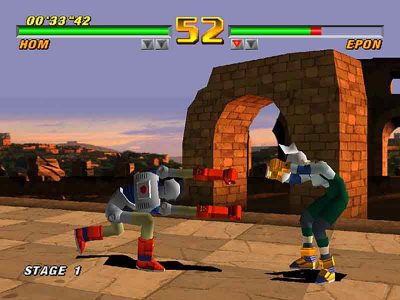
Principais recursos técnicos:
- Jogo roda a 60fps com resolução de 512 x 512 (dimensionado para 640 × 480 / 480i)
- A qualidade da imagem mais "limpa" em comparação com o Tekken 3 e o uso principal de Gouraud Shading nos personagens
- Animação incrível e movimento 3D completo antes de Soul Calibur (e possivelmente executou melhor)
DreamFactory was a modest but star-filled development firm headed by Shiichi Ishii, a developer on Virtua Fighter and director for Tekken. With his industry experience, it shouldn’t be a surprise that their first projects, Tobal No. 1 and Tobal 2, were not only stunning technical feats, but were also some of the first pure 3D fighting games – not just 3D characters on a 2D plane. Namco eventually worked on this concept with Soul Edge and Soul Calibur, but Tobal pioneered it on the PlayStation and pulled it off with a superior resolution and frame rate. Within Tobal, you can dash towards, jump around, and circle around your opponent with complete fluidity and confidence. In another great detail, the characters block differently for each incoming attack.
Tobal No. 2, in particular, feels very organic, smooth, and vibrant. The animation in this brawler is silky smooth with its high frame rate and it has some great touches that gives the game some personality. Tobal 2’s visuals actually rival some N64 titles as the character models are very smooth (unlike Tobal No. 1’s more blocky presentation). Designed by Dragonball Z and Chrono Trigger character designer, Akira Toriyama, the characters have an anime-inspired look to them, but still feel very human. The Gouraud shading and the vibrant colors bring in this feel, but avoid it feeling cartoon-like. The lighting effects are very nice looking as well, especially on the game’s fireballs.
The backgrounds are a combination of 3D objects (sometimes with impressive animation) in the foreground and 2D backdrops in the back. It’s a nice compromise compared to the pure 2D in something like Tekken and Tobal No. 2’s backgrounds have improved significantly from the first installment.
Even with all these great visuals, the Tobal games (and DreamFactory’s other fighter, Ehrgeiz) are the only Playstation fighters to hit 480i at 60fps without many polygon sacrifices. The games actually ran at a very sharp (relatively speaking) 512×512 resolution and then scaled to 640×480. Not many games used the PSX’s 640×480 mode because most games focused on the shimmering textures we all love in. 2stead of the shaded polygons that Tobal pulls off so well.
Unlike Tobal No. 1, No. 2 was never released in the US. It is unfortunate as Tobal No. 2 improves on the original in every aspect. Tobal was also just as impressive (if not more) than the mighty Tekken 3, but we will get into a comparison in just a bit.
TEKKEN 3
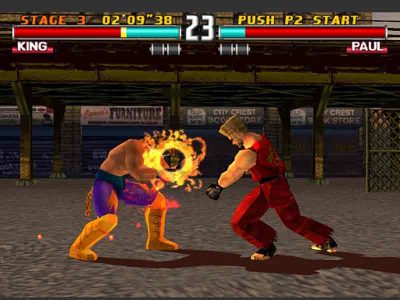
Principais recursos técnicos:
- Port praticamente perfeito de um fliperama/arcade de ponta da época
- Roda a 60 FPS, em 480i (dimensionado de 384 × 480)
- Animação rápida e feita com capturada de movimento
- Personagens com polígonos texturizados para uma aparência mais realista
Sega’s Virtua Fighter had broken into the fighting scene with revolutionary 3D technology in 1993, but within a year or two, Katsuhiro Harada was at Namco working on way to create a strong rival to Sega’s creation. His initial research project revolved around how the body reacts in 3D movement and to replicate something like judo or Chinese kenpo. Harada admits that due to a lack of balancing, “Tekken 1 isn’t really a fighting game. It should be called a human body action game. They have abilities, and they hit each other, but it’s not really a martial arts game.” Developer Yutaka Kounoe added, “the first two games were created as an experiment; even the developers couldn’t predict how it would turn out… The third game which I was in charge of, was a more calculated production.”
With the practice being rather new, Tekken 3 marked the first time Namco used true motion capture techniques for the game (as opposed for simple reference – although their marketing department would mention it for promotion).
Converting from the original arcade versions is always a challenge, but with the third installment, not only was the source game more refined, but the PlayStation port was almost arcade-perfect. The animation speed is impressive and the textures are carefully crafted to make the limited polygon models look as solid as possible. On the original Tekken, the PlayStation version had its animation compressed of 30% from the arcade version. By the time the team had improved their skills for Tekken 3, compression was much less severe – only reduced by 10%. The main compromises from the arcade are a slightly reduced polygon count and the backgrounds are 2D graphics instead of the the sharper 3D backgrounds found in the arcade.
It is interesting to compare some of the most innovative 3D fighters from the era – Tekken 3, Tobal 1 & 2, Virtua Fighter 2 (on the Sega Saturn), and Dead or Alive all had some impressive technical capabilities, but also have some distinct advantages and disadvantages. Tekken 3 and Tobal No. 2 are the top contenders on the PlayStation and it is up for debate which one actually pushed the PlayStation hardware most. Both games run 60 fps at 480i – the best frame rate and video output you can get on the PlayStation. One could argue that the textured polygons in Tekken 3 are more taxing than the shaded polygons in Tobal (but the shading may have actually aged better). However, Tobal No. 2 has 3D elements in its backgrounds (vs pure 2D for Tekken 3) and Tobal No. 2 has more free-range 3D movement to process.
GRAN TURISMO 2
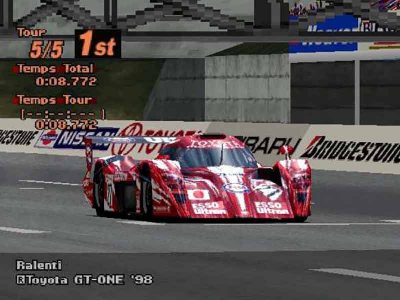
Principais recursos técnicos:
- Modelos detalhados de carros e efeitos de iluminação/reflexo que impulsionaram o realismo para a geração 32 bits
- Modo dinâmico de replay instantâneo
- Mais de 600 carros reais licenciados
* e GranTurismo 1 tinha um modo específico a 60 fPS
As one of the biggest mainstream hits with an attention to detail, we couldn’t overlook Gran Turismo 2’s drive for realism. While the original Gran Turismo was groundbreaking at its release, the sequel had subtle improvements such as lighting effects and car rendering that made it one of the most convincing PlayStation games on the market.
Gran Turismo also has mastered the lighting-effect trick that gives cars a shiny sheen as they drive from camera to camera – an impressive visual that’s coupled with the speed-sensitive hubcap-rotation effects that accurately portray the “whoosh” of cars going past. I realize that the car shining is just a visual trick intended to add to the realism, but you may notice that when cars go through a tunnel, the sunlight still bounces off their hoods.
While he didn’t publicly comment on the sequel, lead developer Kazunori Yamauchi estimated that the original Gran Turismo utilised around 75% of the PlayStation’s maximum performance. Based on the subtle improvements, it is easy to assume Gran Turismo 2 is more toward the 80% to 85% range.
While they ended up becoming an annoyance to gamers over time, the instant replays were a technical showpiece at the time capturing a cinematic point of view to the race, dynamically showing off the top-notch car models and environments.
On a side note, if you would really like to see Gran Turismo 2 look really good, you may find that if you play the game on a PS2 it benefits from the console’s texture smoothing. And Dreamcast owners will get the biggest graphical treat if they use the Gran Turismo 2 Bleemcast disc on Sega’s wonderful white box.
RIDGE RACER TYPE 4
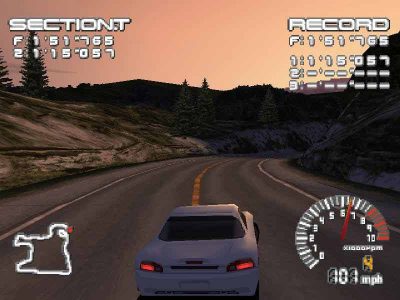
Principais recursos técnicos:
- Roda a 30fps cravados, com texturas detalhadas
- Design ambientais que se adaptam bem aos veículos.
- Boas fontes de luz, e rastros das luzes de freio (brake lights)
The original Ridge Racer was one of PlayStation’s first big system pushers. Regardless of what you thought of Ridge Racer as a game, you had to agree that it was an excellent port of the arcade version that showed the true potential of Sony’s 32-bit wonder. However, in order to compete with the high standard set by the Gran Turismo series, Namco had really bumped up the graphic quality of the Ridge Racer series in Type 4 while staying true to its arcade roots. Ridge Racer Type 4 features a smooth framerate locked solidly on 30 frames per second and lots of detailed textures throughout the game. Also, it hits that target much more reliably that Gran Turismo 2.
The environment design and use of color is especially praiseworthy. When you are cruising around the tracks, the moody skyscapes either share the warmth of summer or put you under the trance of night. The lighting effects on the cars and roads for night time driving give the game a stylish edge that retro gamers appreciate in Japanese-made titles. The whole environment of the game is a work of art and was otherwise unseen on the Playstation.
Ridge Racer Type 4 also works around standard limitations of the PlayStation hardware, such as affine texture mapping issues, by using a healthy volume of triangles for the track’s surface. This approach minimizes warping compared to other Playstation games, including the original Ridge Racer.
The highly-detailed tracks have been arranged in such a way that scenery pop-up is kept to a minimum (except for straight-aways, but it’s barely noticeable). The instant replay mode after a race isn’t quite as dynamic and as up to the quality as Gran Turismo, but it’s certainly detailed enough to hold its own.
Ridge Racer Type 4 has a great use of light sourcing and things like brake lights give off tracers in tunnels. There are still some imperfections in this fourth Ridge Racer increment, however, such as seeing the opposing cars through walls. Nevertheless, this late Playstation racer is still a great sight to behold on Sony’s 32-bit platform.
WIPEOUT 3

Principais recursos técnicos:
- WipEout 3 roda no modo de alta resolução (720 × 480 / 480i), a 30 FPS
- Física legal para dar aos veículos uma sensação "flutuante" autêntica.
- Controle preciso com controles analógicos
- A bomba "Quake Disrupter" realmente altera a pista com um efeito de onda/cascata.
While Ridge Racer was the main technical showpiece during the Japanese launch of the Playstation, WipEout was one of the biggest draws during the Western launch. The team at Psygnosis showed remarkable talent in creating such a stunning 3D racer running at 30fps so early in the Playstation’s life. On top of pure speed, WipEout pulled off the impressive floating element of these futuristic vehicles. The game’s design language and the soundtrack were also crucial to setting itself apart from its competition.
Dominic Mallinson was a lead programmer on WipEout and later became producer on the series (he also went on to become Vice President of Research and Development at Sony’s SCEA division). He attributed much of WipEout’s early success to the team’s background and skill set, “we had a lot of experience with 3D in-house and our artists understood how to create models, render and animate. On the console programming side, we had to scramble a little. We had a few PC developers with experience and we brought them in-house and asked them to help train others. Fortunately, we’d already hired some recent University graduates with strong maths backgrounds to help with tools for the artists and those guys quickly made the transition from off-line to real-time 3D.” He also added, “Probably the biggest technical issue that I remember was dealing with the lack of perspective correct texturing and having to sub-divide the polygons in the track so that they looked OK up-close where the near clip plane is. The problem is that the resolution of the polygon XY positions and the necessity to have T-joints led to cracks in the track. We never did eliminate all the cracks. ”
Even though the game was an early success, the team often focused on the less enthusiastic reviews of the game. WipEout’s Co-Creator, Nick Burcombe admitted, ““We were reading the 7s more than the 9s and nodding about the things that could be improved. It really focused our attention on what we needed to achieve for a sequel.” WipEout 2097 was the team’s second attempt at fleshing out their vision and trying to address the weaknesses that surfaced in the criticism. From a gameplay perspective, the primary changes were the weapons (making it less about slowing down opponents, but bringing more of a grown-up Mario Kart combat strategy) and the way the ships reacted to walls. From a graphical standpoint, the new Quake Disruptor bomb sends an impressive track-altering ripple down the track. The game also improves some of the light sourcing and visual effects to increase the polish.
This leads us to WipEout 3, which is an easy selection of the most technically impressive installment on the PlayStation. Overall, this third installment is faster, deeper, and more refined than its predecessors. It’s also worth noting that support for the Dualshock analog controller also helps give the game more precise control and force feedback.
Graphically, WipEout 3 really shines: the race craft model have more detail and the environments feel more immersive. The craft’s contrails also now act as light sources on the surrounding environments, so a ship’s blue streak will color the walls of a tunnel. The effect is dramatic, especially when you have ships with a number of different colored contrails in a tunnel.
For a nice visual history of the WipEout series, check out HellfireWZ’s “WipEout – Through the Ages” video
Graphics and music have always been especially important to Wipeout, and these later installments, they’re still quite impressive. Pop-up is nonexistent in single-player and not too rough in the multiplayer.
DRIVER 2
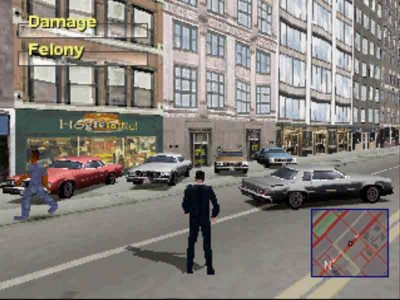
Principais recursos técnicos:
- Execução fenomenal de um conceito de mundo aberto, considerando a RAM limitada no PS1.
- Os veículos tiveram deformações de colisão e outras considerações detalhadas para o realismo.
- Modo direto com sistema de câmera de forma livre.
This innovative and influential series was set out to mimic the feel of 1960s and 1970s car chase films and put you in (partially) faithful recreations of actual city layouts such as Miami, LA, and New York that you could explore in an open world environment. Driver 2 expanded on the free-roam structure of the original and added the ability to step out of your car to explore on foot and commandeer other vehicles in the game’s open world environments. If this sounds familiar, you could say Driver 2 was very influential on the PS2-era Grand Theft Auto titles and the other “sandbox” games that were spawned from GTA’s success. Of course, the Driver series was running well on the PS1 and squeezing what performance it could out of the hardware to make it all happen.
Just as Crash Bandicoot and Spyro gradually redefined what was possible in the platformer genre with 3D capabilities, Driver broke through the expectations for driving games. Up until then, 3D games were very limited in where you could go (although Midtown Madness was released just a couple months earlier on the PC).
Tony Oakden, the lead programmer on Driver, shared the the original Driver started out as a PC game, but was moved to the PS1 as it became a dominant platform, “Technically it was a bit of a nightmare to port code from the PC to the PlayStation… The PlayStation isn’t particularly hard to program for, in my opinion, but by the late 90s it was already quite dated compared to current generation PC with dedicated video cards… The processor was quite a bit slower than the standard PC of the day, there was hardly any RAM, no hardware floating point support at all and a rather primitive rendering system with no Z-Buffer or perspective correction… “So we had to take the version made for the PC, which had all that extra processing power and hardware, and make it work on the Playstation. We had to pull all sorts of tricks to make the game work let alone look good.”
“I think there are a few glitches but you have to remember that this game was pushing the boundaries in terms of what the PlayStation could do. A lot of people said we’d never be able to make a free roaming driving game on the PlayStation at all. That’s the thing about true pioneers isn’t it? They are exciting and great but tend to be a bit rough around the edges.”
In addition to managing the large worlds and all the graphical and data implications that accommodate them, Driver also focused on effects to the vehicles such as crash deformations, flying hubcaps during sharp turns, and smoke from the exhaust pipe and burned rubber. However, when you learn that some of the team members also worked on Destruction Derby, this seems like a natural progression.
On top of the already impressive game, Driver also featured a Director Mode that let the player shoot and cut their own mini car chase movie with a simple, freeform camera system. Most modern games have a similar camera, but it’s mostly for internal purposes of taking media screenshots and trailers. However, touches like this showed that the team at Reflections had a real passion for creativity, maxing out the hardware, and making people take notice.
The texture maps are improved in Driver 2, but there isn’t much more room for improvement over the original with all the complexity of the free-roam environment. Unfortunately, the frame rate does take a hit a bit more and there are some pop-up issues. You can tell the team was really trying to squeeze every last bit that the Playstation could muster.
OMEGA BOOST
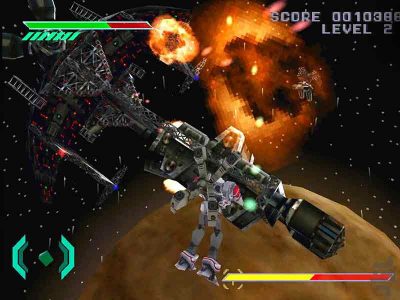
Principais recursos técnicos:
- Dá a impressão de movimento livre em espaço aberto, dentro dos recursos do sistema.
- Impressionantes efeitos de rastro, partículas, reflexões e explosões
- Mantem os 30 fps , e em certas ocasiões roda até 60 fps
In between their work on Gran Turismo and Gran Turismo 2, the team at Polyphony Digital dove into a completely different genre, but still managed to re-define what one could expect out of the Playstation hardware. Omega Boost was a stunning mech-based shooter that had a hybrid on-rails/free-roaming mechanic in open space. Even though the game is on rails for the most part, the large “open” space field gives the illusion of moving where you want.
The game features mecha designs by Shoji Kawamori of Macross fame and the graphics age quite well. Omega Boost is interesting evolution of the shmup genre that wanted to bridge the gap of 2D sprite-based artwork and 3D capabilities that the 32-bit era afforded.. The graphical presentation is impressive, especially during some of the faster interactions. Amazing trail and particle effects are used for many things, reflective surfaces cover the mechs and enemies, and enormous and beautiful explosions erupt every time you take out a boss.
Omega Boost often runs at 60fps, but can occasionally drop to 30fps. Despite the dips in the technical frame-rate, this impressive range in frame rate coupled with the overdraw effects and particles make it seem smoother than it is.
Overall, Omega Boost is a fresh take on a classic shoot-em-up. In some ways, the game reminds me a bit of a 3D take on the arcade classic, Defender – along with the inclusion of a map indicator to help you find where more enemies are. If you enjoy space and mech combat you’ll feel right at home.
It’s also worth mentioning that if you’re a fan of the Panzer Dragoon series on the Sega Saturn, this game should appeal to you – it even has some of the same lock-on shooting mechanism. This is all less surprising when you learn that Omega Boost’s lead designer and programmer, Yuji Yasuhara worked on Panzer Dragoon Zwei with the recently-disbanded Team Andromeda.
QUAKE II
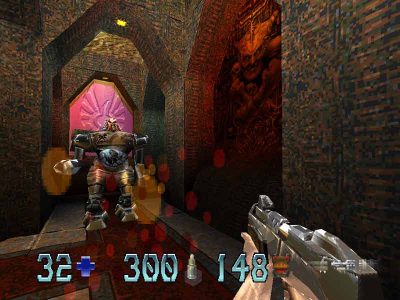
Principais recursos técnicos:
- Engine totalmente personalizada para o hardware do Playstation, em vez de tentar portar a do PC.
- Um FPS moderno (para a época) rodando em resolução de 512 x 240 a 30 fps suaves
- Modo com tela dividida pra 4 jogadores simultâneos
John Carmack had an astounding talent for coming up with new ways to push the limits of hardware (primarily PCs) to display 3D environments and Quake II was one of the biggest breakthroughs in an already impressive string of achievements. Of course, Quake II was developed with a modern (at the time) personal computer equipped with cutting-edge accelerated graphic cards and the Sony Playstation had a much more modest hardware setup (especially when it came to the limited amount of RAM).
Instead of porting Quake II, the development firm, Hammerhead effectively re-created the game from scratch with the Playstation’s hardware limitations in mind while trying to keep the PS1 version as faithful to the original as possible. The end result was incredibly impressive considering the circumstances and became the standard for how first-person shooters on the Playstation (or even the Saturn and N64) should be judged.
Quake II for the Playstation can easily be put in an extreme class of PC to Console ports that focus on extreme optimization for fixed hardware, cutting corners in all the places that more people won’t notice. In an interview, Chris Stanforth, head of development at Hammerhead, shared
“Rather than simply converting the code, we looked at Quake2 in terms of function and figured out ways to replicate that on the PS. This is no criticism of Id’s (superb) approach, just an illustration of the fact that for the best possible result you must work with, and never against the hardware.”
To compensate for the lack of a floating-point capable processor, Hammerhead tackled the challenge with coding the main computational parts of the game engine in assembler and using algorithms with an ideal balance of accuracy and efficiency. Stanforth added,
“We learned a great deal during the ShadowMaster project, although much of that knowledge was gained too late or was inappropriate for use at that time. For Quake II we started again from scratch with a redesigned 3D engine taking full advantage of what we’d learned over the last year. We use a few clever tricks to optimize object clipping, machine-code cores for the most frequently used drawing and math functions, but primarily it’s the way the engine works as a whole that provides the speed.”
To work around the RAM limitation, Hammerhead reformatted the original Quake II maps into chunks that could be handled by the Playstation and then reconstructed them to be as close the original as possible. To keep authenticity levels high, the team avoided using common visual tricks like fogging or strategically placing walls to keep the draw-distance from getting out of hand. Some of the larger levels had to be split over two loads on the Playstation to help compensate for the RAM deficiency, however. There is no skybox for the levels (many gamers may never notice) – instead, a flat Gouraud-textured purple sky is drawn around the top of the level. Other compromises compared to the PC version include removing the ability to crouch (mostly to simplify the control scheme for the Playstation controller).
Many graphical effects were able to replicated in creative ways on the Playstation. Colored lights for levels and enemies and yellow highlights for gunfire and explosions manage to make an appearance on the Playstation version with the addition of lens flare effects located around the light sources on the original lightmaps. Hammerhead’s engine also uses particles to render blood, debris, and rail gun beams to increase the authenticity.
Quake II on the PS1 manages to run in 512 by 240, at a smooth 30fps regardless of the number of players. There is a minor loss of detail for the four-player mode, but given the relatively small display area (given the smaller displays of the day), it was a modest sacrifice.
CONTINUA ABAIXO >
Ano passado, o cara responsável pelo site RacketBoy fez um post pedindo dicas pra um artigo sobre "jogos que exploraram bem o hardware do ps1"... ... eu vi o e-mail de contato dele e escrevi uma listinha de alguns jogos que achei de poderiam entrar, ele não só leu como me respondeu pedindo uma ajuda pra fazer a lista e os motivos de cada jogo entrar. A partir daí trocamos uns 10 e-mails sobre o assunto ....
e depois de um bom tempo, a matéria do PS1 foi finalmente postada. (e agora entendi o motivo da demora, o cara procurou muito mais informações sobre alguns dos jogos da lista principal). E fico feliz que ele aceitou várias das minha sugestões de jogos, alguns na lista principal outros na de menções honrosas. Fica aí a longa matéria, vale a pena ler:
EDIT: traduzi os pontos principais de cada jogo
-----------------------------------------
http://www.racketboy.com/retro/games-that-pushed-the-limits-of-the-sony-playstation-ps1
GAMES THAT PUSHED THE LIMITS OF THE SONY PLAYSTATION (PS1)

As somebody that has a computer science background, I’m always fascinated by games that are the work of skilled developers that learned the intricacies of a console’s hardware to squeeze every last bit of performance from the machine or use some limited resources creatively to accomplish things you didn’t think was possible. Even though it did have some limitations (especially in terms of memory), the Sony Playstation hardware was well-crafted and made it easy for developers to quickly learn how to maximize performance results compared to the Sega Saturn and Nintendo 64 (read our full technical comparison).
Not to downplay some of the stunning visuals that the likes of Square’s art direction and pre-rendered elements, but there is a LOT of competition on the PS1 for some truly impressive coding that really maxed out what the Playstation was capable of. Square will indeed get some mentions below, but you might be surprised by a few developers and games that somehow stayed under the mainstream radar.
One of my other goals in this piece is to try to present diversity – not only in the types of games, but also in the ways developers worked around the limitations of the PS1. There are so many great stories of developers trying new things and accomplishing impressive feats. I hope you find them all fascinating as well!
LEGACY OF KAIN: SOUL REAVER

Principais recursos técnicos:
- Roda com resolução de 512 × 240 - a 30 FPS
- Mundos ambiciosos com grande atenção aos detalhes e efeitos de iluminação incríveis
- Animação de personagens que estava bem à frente de seu tempo
- Técnicas de streaming de dados para produzir mundos contínuos sem Loading
- Elemento de jogo "Dimensional Shifting" que utiliza transformação rápida entre dois ambientes de jogo alternativos
Being released in August of 1999 (after two and a half years of development) Soul Reaver was up against the upcoming US release of the Sega Dreamcast and Legend of Zelda: Ocarina of Time had redefined gamer’s expectations of action adventure titles. However, Crystal Dynamics’ labor of love ended up being possibly the biggest technical achievement of the Playstation’s library while sharing an ambitious interactive storytelling experience.
While the development drama of Soul Reaver is fascinating, we will focus on the technical achievements that came to fruition from all the long nights and drama. Soul Reaver ran on Crystal Dynamics’ proprietary Gex engine(which was originally used on Gex and built on top of what they learned while working on Tomb Raider) along with some code for character animation that they developed for 3D Baseball (which was ahead of its time in terms of motion capture, but lacked the benefits of an MLB license). The Gex engine chunked large levels into sections and then streamed the level data as needed to the system memory. It kept the player’s current section and the two adjacent sections in memory to keep loading to an absolute minimum. (In addition to the two Gex titles and Soul Reaver, the Gex engine was use used on Akuji).
Soul Reaver’s Game Director, Amy Hennig admitted that the data streaming was their biggest challenge during development:
“It proved to be way more difficult than we had initially anticipated – if I recall, we were still struggling to get the textures to dynamically pack correctly, just a couple months before release. We ultimately got it working by the skin of our teeth, but I wonder if we would’ve embarked on such an ambitious plan if we’d known how difficult it was going to be!”

Since the CD-ROM gave developers more storage than they needed for the game, multiple copies of textures were loaded on different parts of the CD-ROM so that they were slightly quicker to access depending on where the disc was already reading. This avoidance of loading time overcame one of the most common drawbacks of the 2X CD-ROM based PS1/Saturn compared to the cartridge-based N64. Some other PS1 titles pulled off a similar strategy, but Soul Reaver was one of the first and most impressive in its execution.
To complicate the technical challenges further, the game features dimensional shifting, letting players jump between the material and spectral planes of the game at will. This gameplay element is critical to the game’s story-telling and plays in heavily for puzzle-solving elements. The developers essentially had to keep two variations of the game environment loaded at all times. Between most of the two variations the basic map data is the same, but there is an adjustment of the underlying geometry and color data.
Amy Hennig also shared that dealing with the shift in realms was the team’s second largest challenge:
“Our initial plan was over-ambitious, involving texture-morphing as well as geometry-morphing, but we realised pretty early on that our texture memory (and time) was too limited to achieve this.
We came up with the idea of leveraging the 3DS Max animation timeline to attach spectral values to the vertices in the geometry – i.e., frame 0 was the material world, and frame 1 was the spectral realm (or vice versa; I can’t remember for sure). This way we could alter the x,y,z coordinates of each vertex, as well as its RGB lighting values, to create a twisted, more eerily lit version of the physical realm.”
Soul Reaver’s soundtrack often gets a lot of acclaim. Even though it could have been simple to include pre-recorded CD audio on a PlayStation game, Soul Reaver actually uses a high-quality sequenced audio (similar to the SNES) that could dynamically altered and shifted based on what is happening on the screen. The Crystal Dynamics team was able to create a soundtrack of phenomenal quality while taking up very little storage space on the disc. DF Retro’s 36 minute Soul Reaver video digs into some of these.
On top of all this, Soul Reaver runs at a resolution of 512×240 while targeting 30 fps. While it does have some occasional slowdown dipping into the 20 fps zone during larger areas and battling larger quantities of enemies, this is still impressive considering something like Legend of Zelda: Ocarina of Time on the N64 only ran at 320×240 at about 20 fps during the same time period.
Soul Reaver contains some of most impressive character animations and lighting effects to be found in the 32-bit era. Whether he is roaming the sprawling worlds, moving blocks in this 3D puzzle adventure, hovering, or swimming, Raziel always appears to move naturally and fluidly. The levels, object types lists, color lookup tables, and variations of textures were used to efficiently display a hauntingly dynamic environment.
METAL GEAR SOLID

Principais recursos técnicos:
- Um estilo de jogo cinematográfico que cria uma experiência envolvente e perfeita
- Uso criativo de texturas e level design para contornar as limitações do hardware
- Otimizando partes cruciais do código e transformando-as em linguagem assembly
- Explora outras partes do hardware do PlayStation (memorycard e controle) para criar elementos de jogabilidade inovadores
Metal Gear Solid is an iconic choice for utilizing the same mind-boggling game engine for its real-time cinemas, which creates a seamless transition from a game sequence to a cut-scene. Game director Hideo Kojima had also implemented a blurring effect to give Metal Gear Solid a movie-like feel.
With many of the innovative art direction and storytelling choices made in Metal Gear Solid, it is easy to overlook many of the technical optimizations accomplished by Konami’s team to create a game that would not only make the most of the Playstation’s hardware but would be an entity that would age relatively well at such an evolutionary stage for console gaming and is one of the most defining games on the PS1.
Nearly every object in Metal Gear Solid (including Snake) is polygonal, however, Kojima and the team kept the polygon count low and leaned more on creative use of textures and rendering perspective. Thanks to these thoughtful techniques, Metal Gear Solid shows very few clipping errors and the characters move very smoothly.

Textures were also used creatively to create a more realistic and engaging environment. Rather than having a large number of unique textures, MGS creatively layered a smaller number of common textures to generate a unique look for a given surface. There was much creativity used to design and store levels – possibly using a BSP (Binary Space Partitioning ) engine since most of the game took place in corridors or boxy/cube styled levels. This technique was pioneered by the DOOM and Quake engines.
The effective use of polygons and textures was a solid foundation for Metal Gear Solid, but Konami took it one step further by having a dedicated “optimization” programmer that went through all the code to find crucial points of the engine to turn into assembly code. (Mostly to get models to fit nicely in the PS1’s small 1kb fast-cache)
On top of the already impressive game engine, the attention to detail, considering the technical limitations, is astounding. You make footprints in the snow that will eventually get covered up by snowfall. You can identify guards and other characters by their breath in the cold air. Water effects are accurate, light sourcing is dead-on, and the textures are solid.
Another way that Metal Gear Solid pushed the limits does not have anything to do with graphics, but instead it depends on the pure creativity of Kojima and the MGS team. The game had a numbers of points in the story where the memory card and/or controller is utilized creatively to enhance the game experience or serve as an “Easter egg”. If you don’t mind some spoilers, you can read more about these instances at Wikipedia.
CRASH BANDICOOT SERIES

Principais recursos técnicos:
- A equipe criou seu próprio ecossistema de desenvolvimento para maximizar o hardware PlayStation para fins de plataformas 3D - completo com linguagem de programação personalizada
- Usou o modo de vídeo de 512 × 240 com muitos polígonos sombreados, mas não texturizados, para uma aparência de desenho animado e com alto desempenho.
- Sistema de multi-articulações desenvolvido para modelos de personagens para ajudar na animação semelhante a um desenho animado
- As sequências adicionaram muitos efeitos de água do tipo Z-buffer, clima, reflexos, partículas, cabeças de holograma falantes, além de um estilo de movimentação mais livre e distâncias de visualização aumentadas.
The two guys at Naughty Dog did an amazing job of being relatively new to the game dev scene and looking for an opportunity (filling the gap of a 3D platformer, Virtua Fighter and Ridge Racer/Virtua Racing had fighting and racing covered at the time, and simultaneously trying to fill a gap of a mascot character for Sony).
They also got their hands dirty quickly and kept learning as they worked on their first fully–3D game. They did a lot of impressive problem-solving and innovation, especially for a small upstart, but didn’t rest on their laurels after a single success. They continued to work on refining both the gameplay and engine of their game and also their internal development processes as they worked on the sequels. This process could easily be compared to what we have all experienced as gamers: the first time you play a game or a certain level, you’re trying to out what needs to be done to be successful. But after you made it through most of the battle the first time, you now have a better idea how to play through it again – learning from your mistakes and taking new approaches that could work better. (See this classic scene from Scott Pilgrim vs The World ** spoilers **) While the original Crash Bandicoot was pushing the PlayStation when it arrived, this constant refinement and growth at Naughty Dog resulted in Crash 3 pushing the limits all the more.(You can read about Naughty Dog’s evolution in their processes here)

Naughty Dog started Crash’s foundation by utilizing the 512×240 video mode that most developers skipped, but when they used it for shaded, but untextured polygons, they realized that it resulted in a sharper, more cartoon-like result that rendered just as fast as the lower-resolution modes. They also were able to use more polygons, so they worked around the PS1’s lack of texture correction and polygon clipping.
To help with the more cartoon-like animation, they used a sophisticated three or four-joint weighing system instead of a 1-joint system with few “bones” that a lot of developers were using at the time. They used high-end animation software on their PCs and then mapped every vertex for every frame at 30 fps since the PS1 couldn’t render it in realtime. The also wrote their own vertex compressors in assembly language to optimize the processing efficiency.
To develop Crash’s compelling environments, they studied visibility calculation intensely so they could handle many more polygons that most developers thought. Andy Gavin shared,
“We did experiments in free roaming camera control and settled on branching rail camera + pre-calculation = gorgeous visuals. The idea was that the camera would follow along next to, behind, or in front of the character, generally looking at him, moving on a “track” through the world. Dave and I experimented with pre-calculating the visibility and sort (the Playstation had no z-buffer, and hence no easy way to sort polygons) ahead of time on the SGI workstations the artists used. Although painful and expensive, this worked really well. As long as you could never SEE more than a set number of polygons (800 for Crash 1, 1300 for Crash 2 or 3) from any given position we could have perfect occlusion and sort, with no runtime cost. We conceived of using trees, cliffs, walls, and twists and turns in the environment to hide a lot of the landscape from view – but it would be there, just around the corner.”
Andy also did some other crazy coding work that would help create a system for making their work efficient and make the most of the Playstation’s resources. Their level designs came out at about 8 to 16 megs each, so he developed an algorithmic texture packer that would efficiently cram the levels into the PS1’s 2 megs of RAM. Some of the levels came out at 128meg, so Dave created a bidirectional 10x compressor to help get the 128meg levels down into 12 and also developed a tool for managing the construction of the gigantic 3D worlds. On top of all that, Andy created a new programming language (with Lisp syntax) that featured “all sorts of built in state machine support (very useful with game objects), powerful macros, dynamic loading etc.”.
All these incredibly custom approaches and innovations led to rumors that Naughty Dog had access to some secret development library from Sony. In reality, Sony’s own developers struggled to pull off a lot of the same results when developing similar games.
As much as we praised Legacy of Kain: Soul Reaver (above) for their innovative techniques for reducing load times down to a minimum, Soul Reaver’s Game Director, Amy Hennig was quick to point out that Naughty Dog’s work on Crash Bandicoot was another early example of this type of problem-solving. Naughty Dog actually took a different approach that helped with both load time and figuring out which items to load into the system’s limited memory. Andy recalls,
“The Crash series employs an extremely complicated virtual memory scheme which dynamically swaps into memory any kind of game component: geometry, animation, texture, code, sound, collision data, camera data, etc. A workstation based tool called NPT implements an expert system for laying out the disk. This tool belongs to the class of formal Artificial Intelligence programs. Its job is to figure out how the 500 to 1000 resources that make up a Crash level can be arranged so as to never have more than 1.2 megabytes needed in memory at any time. A multithreaded virtual memory implementation follows the instructions produced by the tool in order to achieve this effect at run time. Together they manage and optimize the essential resources of main, texture, and sound RAM based on a larger CD based database.”
Because of this, the team was actually a bit concerned that Crash was accessing the CD more than the PS1’s drive was rated for. So if you ever notice that it seems like the drive is being read a lot while playing, you’ll know why.
For Crash 2, the team at Naughty Dog rewrote approximately 80% of the game engine and tool code based on the lessons they learned and the bottlenecks they saw in the first game. In the end, Crash 2 aimed for twice as much on the screen while maintaining the 30 frames per second. It also added more effects such as Z-buffer-like water effects, weather, reflections, particles, talking hologram heads, etc.
Crash 3 challenged the team to develop new engines or sub-engines to power a more free-roaming 3D style, up to 10X longer view distances, and more level of detail features. They had to overhaul the background polygon resource manager and the AI memory manager to handle the increasingly large firehouse of data that had to be processed for the game.
SPYRO THE DRAGON SERIES

Principais recursos técnicos:
- Ofereceu movimento de vôo completo que controlou fenomenalmente com ou sem controles analógicos.
- Sistema pioneiro de LOD (nível de detalhe) para aumentar as distância de visibilidade (sem “fog/nevoeiro”).
- Sombreamento de polígono para um visual sólido de desenhos animados.
- As sequencias adicionaram reflexos de gelo, iluminação semi-dinâmica e sistemas impressionantes de partículas para fogo, água, fumaça, explosões e outros refinamentos gráficos.
After Super Mario 64 and Rare’s Banjo-Kazooie on the N64 has made its mark and Naughty Dog was about to release its third installment with Crash Bandicoot: Warped, another upstart studio by the name of Insomniac Games unleashed a new platformer for the PlayStation with a 3D panoramic engine to allow the players to have open exploration without restrictions of how far you can go.
With this ambitious plan of flying and full movement, the Insomniac team needed to figure out how to handle long view distances without the “fog” that was common in this console generation. Insomniac developer Peter Hastings explained the team’s fresh take on the problem: “There were actually two separate worlds being rendered in a Spyro level. Each level had a detailed version built out of textured polygons, and a much more impressionistic, simple version built out of fast-rendering untextured polygons. For anything near the player, the detailed world was drawn, but for distant objects the simple version was used. This ‘Level-Of-Detail’ system is now used by pretty much every game on the planet, but at the time it was quite new.” Alex Hastings, Insomniac’s VP of Software built the panoramic ending using Assembly draw routines for seven different renderers that worked on a different level of detail in the environment (Alex claimed that 80% of Spyro was written in assembly for peak efficiency). Alex knew that the PlayStation could handle many more polygons than the other consoles (and even many PCs) at the time, so him programming these ambitious engines in assembly was the best way for their new title to stand out from the crowd.
To supplement the expansive worlds, Matt Whiting and his experience designing flight systems for NASA was a critical part of developing Spyro’s control system and camera code. Hastings praised Whiting’s contributions, “the smoothness of the controls is owed to his ability to squeeze a great deal of matrix algebra into the tiny slice of computational time that the PlayStation could give us.” The natural and smooth controls found in Spyro are especially impressive when you realize this was before the PlayStation controller had analogue controls – you get just as good control with the standard D-Pad.
Being essentially down the hall from the guys at Naughty Dog, the team at Insomniac often traded technical tips and tricks with each other. It shouldn’t be too much of a surprise that Spyro takes some pages out of the Crash playbook to use untextured polygons, but add Gouraud shading to achieve the great cartoon styling for the characters. This technique also lended itself well to sharp character models and high frame rates and sense of speed (especially in the chase levels featured in Spyro 2 and 3).
By the time Spyro 3 was published, Insomniac was pulling off great ice reflections, semi-dynamic lighting and a lot of impressive particle systems for fire, water, smoke, and explosions. There were also many subtle graphical and animation refinements from the previous installments that were already technical marvels. It was obvious that the team had become skilled professionals of creating a clean and cohesive visual package on the PlayStation.
TOBAL Nº2

Principais recursos técnicos:
- Jogo roda a 60fps com resolução de 512 x 512 (dimensionado para 640 × 480 / 480i)
- A qualidade da imagem mais "limpa" em comparação com o Tekken 3 e o uso principal de Gouraud Shading nos personagens
- Animação incrível e movimento 3D completo antes de Soul Calibur (e possivelmente executou melhor)
DreamFactory was a modest but star-filled development firm headed by Shiichi Ishii, a developer on Virtua Fighter and director for Tekken. With his industry experience, it shouldn’t be a surprise that their first projects, Tobal No. 1 and Tobal 2, were not only stunning technical feats, but were also some of the first pure 3D fighting games – not just 3D characters on a 2D plane. Namco eventually worked on this concept with Soul Edge and Soul Calibur, but Tobal pioneered it on the PlayStation and pulled it off with a superior resolution and frame rate. Within Tobal, you can dash towards, jump around, and circle around your opponent with complete fluidity and confidence. In another great detail, the characters block differently for each incoming attack.
Tobal No. 2, in particular, feels very organic, smooth, and vibrant. The animation in this brawler is silky smooth with its high frame rate and it has some great touches that gives the game some personality. Tobal 2’s visuals actually rival some N64 titles as the character models are very smooth (unlike Tobal No. 1’s more blocky presentation). Designed by Dragonball Z and Chrono Trigger character designer, Akira Toriyama, the characters have an anime-inspired look to them, but still feel very human. The Gouraud shading and the vibrant colors bring in this feel, but avoid it feeling cartoon-like. The lighting effects are very nice looking as well, especially on the game’s fireballs.
The backgrounds are a combination of 3D objects (sometimes with impressive animation) in the foreground and 2D backdrops in the back. It’s a nice compromise compared to the pure 2D in something like Tekken and Tobal No. 2’s backgrounds have improved significantly from the first installment.
Even with all these great visuals, the Tobal games (and DreamFactory’s other fighter, Ehrgeiz) are the only Playstation fighters to hit 480i at 60fps without many polygon sacrifices. The games actually ran at a very sharp (relatively speaking) 512×512 resolution and then scaled to 640×480. Not many games used the PSX’s 640×480 mode because most games focused on the shimmering textures we all love in. 2stead of the shaded polygons that Tobal pulls off so well.
Unlike Tobal No. 1, No. 2 was never released in the US. It is unfortunate as Tobal No. 2 improves on the original in every aspect. Tobal was also just as impressive (if not more) than the mighty Tekken 3, but we will get into a comparison in just a bit.
TEKKEN 3

Principais recursos técnicos:
- Port praticamente perfeito de um fliperama/arcade de ponta da época
- Roda a 60 FPS, em 480i (dimensionado de 384 × 480)
- Animação rápida e feita com capturada de movimento
- Personagens com polígonos texturizados para uma aparência mais realista
Sega’s Virtua Fighter had broken into the fighting scene with revolutionary 3D technology in 1993, but within a year or two, Katsuhiro Harada was at Namco working on way to create a strong rival to Sega’s creation. His initial research project revolved around how the body reacts in 3D movement and to replicate something like judo or Chinese kenpo. Harada admits that due to a lack of balancing, “Tekken 1 isn’t really a fighting game. It should be called a human body action game. They have abilities, and they hit each other, but it’s not really a martial arts game.” Developer Yutaka Kounoe added, “the first two games were created as an experiment; even the developers couldn’t predict how it would turn out… The third game which I was in charge of, was a more calculated production.”
With the practice being rather new, Tekken 3 marked the first time Namco used true motion capture techniques for the game (as opposed for simple reference – although their marketing department would mention it for promotion).
Converting from the original arcade versions is always a challenge, but with the third installment, not only was the source game more refined, but the PlayStation port was almost arcade-perfect. The animation speed is impressive and the textures are carefully crafted to make the limited polygon models look as solid as possible. On the original Tekken, the PlayStation version had its animation compressed of 30% from the arcade version. By the time the team had improved their skills for Tekken 3, compression was much less severe – only reduced by 10%. The main compromises from the arcade are a slightly reduced polygon count and the backgrounds are 2D graphics instead of the the sharper 3D backgrounds found in the arcade.
It is interesting to compare some of the most innovative 3D fighters from the era – Tekken 3, Tobal 1 & 2, Virtua Fighter 2 (on the Sega Saturn), and Dead or Alive all had some impressive technical capabilities, but also have some distinct advantages and disadvantages. Tekken 3 and Tobal No. 2 are the top contenders on the PlayStation and it is up for debate which one actually pushed the PlayStation hardware most. Both games run 60 fps at 480i – the best frame rate and video output you can get on the PlayStation. One could argue that the textured polygons in Tekken 3 are more taxing than the shaded polygons in Tobal (but the shading may have actually aged better). However, Tobal No. 2 has 3D elements in its backgrounds (vs pure 2D for Tekken 3) and Tobal No. 2 has more free-range 3D movement to process.
GRAN TURISMO 2

Principais recursos técnicos:
- Modelos detalhados de carros e efeitos de iluminação/reflexo que impulsionaram o realismo para a geração 32 bits
- Modo dinâmico de replay instantâneo
- Mais de 600 carros reais licenciados
* e GranTurismo 1 tinha um modo específico a 60 fPS
As one of the biggest mainstream hits with an attention to detail, we couldn’t overlook Gran Turismo 2’s drive for realism. While the original Gran Turismo was groundbreaking at its release, the sequel had subtle improvements such as lighting effects and car rendering that made it one of the most convincing PlayStation games on the market.
Gran Turismo also has mastered the lighting-effect trick that gives cars a shiny sheen as they drive from camera to camera – an impressive visual that’s coupled with the speed-sensitive hubcap-rotation effects that accurately portray the “whoosh” of cars going past. I realize that the car shining is just a visual trick intended to add to the realism, but you may notice that when cars go through a tunnel, the sunlight still bounces off their hoods.
While he didn’t publicly comment on the sequel, lead developer Kazunori Yamauchi estimated that the original Gran Turismo utilised around 75% of the PlayStation’s maximum performance. Based on the subtle improvements, it is easy to assume Gran Turismo 2 is more toward the 80% to 85% range.
While they ended up becoming an annoyance to gamers over time, the instant replays were a technical showpiece at the time capturing a cinematic point of view to the race, dynamically showing off the top-notch car models and environments.
On a side note, if you would really like to see Gran Turismo 2 look really good, you may find that if you play the game on a PS2 it benefits from the console’s texture smoothing. And Dreamcast owners will get the biggest graphical treat if they use the Gran Turismo 2 Bleemcast disc on Sega’s wonderful white box.
RIDGE RACER TYPE 4

Principais recursos técnicos:
- Roda a 30fps cravados, com texturas detalhadas
- Design ambientais que se adaptam bem aos veículos.
- Boas fontes de luz, e rastros das luzes de freio (brake lights)
The original Ridge Racer was one of PlayStation’s first big system pushers. Regardless of what you thought of Ridge Racer as a game, you had to agree that it was an excellent port of the arcade version that showed the true potential of Sony’s 32-bit wonder. However, in order to compete with the high standard set by the Gran Turismo series, Namco had really bumped up the graphic quality of the Ridge Racer series in Type 4 while staying true to its arcade roots. Ridge Racer Type 4 features a smooth framerate locked solidly on 30 frames per second and lots of detailed textures throughout the game. Also, it hits that target much more reliably that Gran Turismo 2.
The environment design and use of color is especially praiseworthy. When you are cruising around the tracks, the moody skyscapes either share the warmth of summer or put you under the trance of night. The lighting effects on the cars and roads for night time driving give the game a stylish edge that retro gamers appreciate in Japanese-made titles. The whole environment of the game is a work of art and was otherwise unseen on the Playstation.
Ridge Racer Type 4 also works around standard limitations of the PlayStation hardware, such as affine texture mapping issues, by using a healthy volume of triangles for the track’s surface. This approach minimizes warping compared to other Playstation games, including the original Ridge Racer.
The highly-detailed tracks have been arranged in such a way that scenery pop-up is kept to a minimum (except for straight-aways, but it’s barely noticeable). The instant replay mode after a race isn’t quite as dynamic and as up to the quality as Gran Turismo, but it’s certainly detailed enough to hold its own.
Ridge Racer Type 4 has a great use of light sourcing and things like brake lights give off tracers in tunnels. There are still some imperfections in this fourth Ridge Racer increment, however, such as seeing the opposing cars through walls. Nevertheless, this late Playstation racer is still a great sight to behold on Sony’s 32-bit platform.
WIPEOUT 3

Principais recursos técnicos:
- WipEout 3 roda no modo de alta resolução (720 × 480 / 480i), a 30 FPS
- Física legal para dar aos veículos uma sensação "flutuante" autêntica.
- Controle preciso com controles analógicos
- A bomba "Quake Disrupter" realmente altera a pista com um efeito de onda/cascata.
While Ridge Racer was the main technical showpiece during the Japanese launch of the Playstation, WipEout was one of the biggest draws during the Western launch. The team at Psygnosis showed remarkable talent in creating such a stunning 3D racer running at 30fps so early in the Playstation’s life. On top of pure speed, WipEout pulled off the impressive floating element of these futuristic vehicles. The game’s design language and the soundtrack were also crucial to setting itself apart from its competition.
Dominic Mallinson was a lead programmer on WipEout and later became producer on the series (he also went on to become Vice President of Research and Development at Sony’s SCEA division). He attributed much of WipEout’s early success to the team’s background and skill set, “we had a lot of experience with 3D in-house and our artists understood how to create models, render and animate. On the console programming side, we had to scramble a little. We had a few PC developers with experience and we brought them in-house and asked them to help train others. Fortunately, we’d already hired some recent University graduates with strong maths backgrounds to help with tools for the artists and those guys quickly made the transition from off-line to real-time 3D.” He also added, “Probably the biggest technical issue that I remember was dealing with the lack of perspective correct texturing and having to sub-divide the polygons in the track so that they looked OK up-close where the near clip plane is. The problem is that the resolution of the polygon XY positions and the necessity to have T-joints led to cracks in the track. We never did eliminate all the cracks. ”
Even though the game was an early success, the team often focused on the less enthusiastic reviews of the game. WipEout’s Co-Creator, Nick Burcombe admitted, ““We were reading the 7s more than the 9s and nodding about the things that could be improved. It really focused our attention on what we needed to achieve for a sequel.” WipEout 2097 was the team’s second attempt at fleshing out their vision and trying to address the weaknesses that surfaced in the criticism. From a gameplay perspective, the primary changes were the weapons (making it less about slowing down opponents, but bringing more of a grown-up Mario Kart combat strategy) and the way the ships reacted to walls. From a graphical standpoint, the new Quake Disruptor bomb sends an impressive track-altering ripple down the track. The game also improves some of the light sourcing and visual effects to increase the polish.
This leads us to WipEout 3, which is an easy selection of the most technically impressive installment on the PlayStation. Overall, this third installment is faster, deeper, and more refined than its predecessors. It’s also worth noting that support for the Dualshock analog controller also helps give the game more precise control and force feedback.
Graphically, WipEout 3 really shines: the race craft model have more detail and the environments feel more immersive. The craft’s contrails also now act as light sources on the surrounding environments, so a ship’s blue streak will color the walls of a tunnel. The effect is dramatic, especially when you have ships with a number of different colored contrails in a tunnel.
For a nice visual history of the WipEout series, check out HellfireWZ’s “WipEout – Through the Ages” video
Graphics and music have always been especially important to Wipeout, and these later installments, they’re still quite impressive. Pop-up is nonexistent in single-player and not too rough in the multiplayer.
DRIVER 2

Principais recursos técnicos:
- Execução fenomenal de um conceito de mundo aberto, considerando a RAM limitada no PS1.
- Os veículos tiveram deformações de colisão e outras considerações detalhadas para o realismo.
- Modo direto com sistema de câmera de forma livre.
This innovative and influential series was set out to mimic the feel of 1960s and 1970s car chase films and put you in (partially) faithful recreations of actual city layouts such as Miami, LA, and New York that you could explore in an open world environment. Driver 2 expanded on the free-roam structure of the original and added the ability to step out of your car to explore on foot and commandeer other vehicles in the game’s open world environments. If this sounds familiar, you could say Driver 2 was very influential on the PS2-era Grand Theft Auto titles and the other “sandbox” games that were spawned from GTA’s success. Of course, the Driver series was running well on the PS1 and squeezing what performance it could out of the hardware to make it all happen.
Just as Crash Bandicoot and Spyro gradually redefined what was possible in the platformer genre with 3D capabilities, Driver broke through the expectations for driving games. Up until then, 3D games were very limited in where you could go (although Midtown Madness was released just a couple months earlier on the PC).
Tony Oakden, the lead programmer on Driver, shared the the original Driver started out as a PC game, but was moved to the PS1 as it became a dominant platform, “Technically it was a bit of a nightmare to port code from the PC to the PlayStation… The PlayStation isn’t particularly hard to program for, in my opinion, but by the late 90s it was already quite dated compared to current generation PC with dedicated video cards… The processor was quite a bit slower than the standard PC of the day, there was hardly any RAM, no hardware floating point support at all and a rather primitive rendering system with no Z-Buffer or perspective correction… “So we had to take the version made for the PC, which had all that extra processing power and hardware, and make it work on the Playstation. We had to pull all sorts of tricks to make the game work let alone look good.”
“I think there are a few glitches but you have to remember that this game was pushing the boundaries in terms of what the PlayStation could do. A lot of people said we’d never be able to make a free roaming driving game on the PlayStation at all. That’s the thing about true pioneers isn’t it? They are exciting and great but tend to be a bit rough around the edges.”
In addition to managing the large worlds and all the graphical and data implications that accommodate them, Driver also focused on effects to the vehicles such as crash deformations, flying hubcaps during sharp turns, and smoke from the exhaust pipe and burned rubber. However, when you learn that some of the team members also worked on Destruction Derby, this seems like a natural progression.
On top of the already impressive game, Driver also featured a Director Mode that let the player shoot and cut their own mini car chase movie with a simple, freeform camera system. Most modern games have a similar camera, but it’s mostly for internal purposes of taking media screenshots and trailers. However, touches like this showed that the team at Reflections had a real passion for creativity, maxing out the hardware, and making people take notice.
The texture maps are improved in Driver 2, but there isn’t much more room for improvement over the original with all the complexity of the free-roam environment. Unfortunately, the frame rate does take a hit a bit more and there are some pop-up issues. You can tell the team was really trying to squeeze every last bit that the Playstation could muster.
OMEGA BOOST

Principais recursos técnicos:
- Dá a impressão de movimento livre em espaço aberto, dentro dos recursos do sistema.
- Impressionantes efeitos de rastro, partículas, reflexões e explosões
- Mantem os 30 fps , e em certas ocasiões roda até 60 fps
In between their work on Gran Turismo and Gran Turismo 2, the team at Polyphony Digital dove into a completely different genre, but still managed to re-define what one could expect out of the Playstation hardware. Omega Boost was a stunning mech-based shooter that had a hybrid on-rails/free-roaming mechanic in open space. Even though the game is on rails for the most part, the large “open” space field gives the illusion of moving where you want.
The game features mecha designs by Shoji Kawamori of Macross fame and the graphics age quite well. Omega Boost is interesting evolution of the shmup genre that wanted to bridge the gap of 2D sprite-based artwork and 3D capabilities that the 32-bit era afforded.. The graphical presentation is impressive, especially during some of the faster interactions. Amazing trail and particle effects are used for many things, reflective surfaces cover the mechs and enemies, and enormous and beautiful explosions erupt every time you take out a boss.
Omega Boost often runs at 60fps, but can occasionally drop to 30fps. Despite the dips in the technical frame-rate, this impressive range in frame rate coupled with the overdraw effects and particles make it seem smoother than it is.
Overall, Omega Boost is a fresh take on a classic shoot-em-up. In some ways, the game reminds me a bit of a 3D take on the arcade classic, Defender – along with the inclusion of a map indicator to help you find where more enemies are. If you enjoy space and mech combat you’ll feel right at home.
It’s also worth mentioning that if you’re a fan of the Panzer Dragoon series on the Sega Saturn, this game should appeal to you – it even has some of the same lock-on shooting mechanism. This is all less surprising when you learn that Omega Boost’s lead designer and programmer, Yuji Yasuhara worked on Panzer Dragoon Zwei with the recently-disbanded Team Andromeda.
QUAKE II

Principais recursos técnicos:
- Engine totalmente personalizada para o hardware do Playstation, em vez de tentar portar a do PC.
- Um FPS moderno (para a época) rodando em resolução de 512 x 240 a 30 fps suaves
- Modo com tela dividida pra 4 jogadores simultâneos
John Carmack had an astounding talent for coming up with new ways to push the limits of hardware (primarily PCs) to display 3D environments and Quake II was one of the biggest breakthroughs in an already impressive string of achievements. Of course, Quake II was developed with a modern (at the time) personal computer equipped with cutting-edge accelerated graphic cards and the Sony Playstation had a much more modest hardware setup (especially when it came to the limited amount of RAM).
Instead of porting Quake II, the development firm, Hammerhead effectively re-created the game from scratch with the Playstation’s hardware limitations in mind while trying to keep the PS1 version as faithful to the original as possible. The end result was incredibly impressive considering the circumstances and became the standard for how first-person shooters on the Playstation (or even the Saturn and N64) should be judged.
Quake II for the Playstation can easily be put in an extreme class of PC to Console ports that focus on extreme optimization for fixed hardware, cutting corners in all the places that more people won’t notice. In an interview, Chris Stanforth, head of development at Hammerhead, shared
“Rather than simply converting the code, we looked at Quake2 in terms of function and figured out ways to replicate that on the PS. This is no criticism of Id’s (superb) approach, just an illustration of the fact that for the best possible result you must work with, and never against the hardware.”
To compensate for the lack of a floating-point capable processor, Hammerhead tackled the challenge with coding the main computational parts of the game engine in assembler and using algorithms with an ideal balance of accuracy and efficiency. Stanforth added,
“We learned a great deal during the ShadowMaster project, although much of that knowledge was gained too late or was inappropriate for use at that time. For Quake II we started again from scratch with a redesigned 3D engine taking full advantage of what we’d learned over the last year. We use a few clever tricks to optimize object clipping, machine-code cores for the most frequently used drawing and math functions, but primarily it’s the way the engine works as a whole that provides the speed.”
To work around the RAM limitation, Hammerhead reformatted the original Quake II maps into chunks that could be handled by the Playstation and then reconstructed them to be as close the original as possible. To keep authenticity levels high, the team avoided using common visual tricks like fogging or strategically placing walls to keep the draw-distance from getting out of hand. Some of the larger levels had to be split over two loads on the Playstation to help compensate for the RAM deficiency, however. There is no skybox for the levels (many gamers may never notice) – instead, a flat Gouraud-textured purple sky is drawn around the top of the level. Other compromises compared to the PC version include removing the ability to crouch (mostly to simplify the control scheme for the Playstation controller).
Many graphical effects were able to replicated in creative ways on the Playstation. Colored lights for levels and enemies and yellow highlights for gunfire and explosions manage to make an appearance on the Playstation version with the addition of lens flare effects located around the light sources on the original lightmaps. Hammerhead’s engine also uses particles to render blood, debris, and rail gun beams to increase the authenticity.
Quake II on the PS1 manages to run in 512 by 240, at a smooth 30fps regardless of the number of players. There is a minor loss of detail for the four-player mode, but given the relatively small display area (given the smaller displays of the day), it was a modest sacrifice.
CONTINUA ABAIXO >
Ultima Edição:

